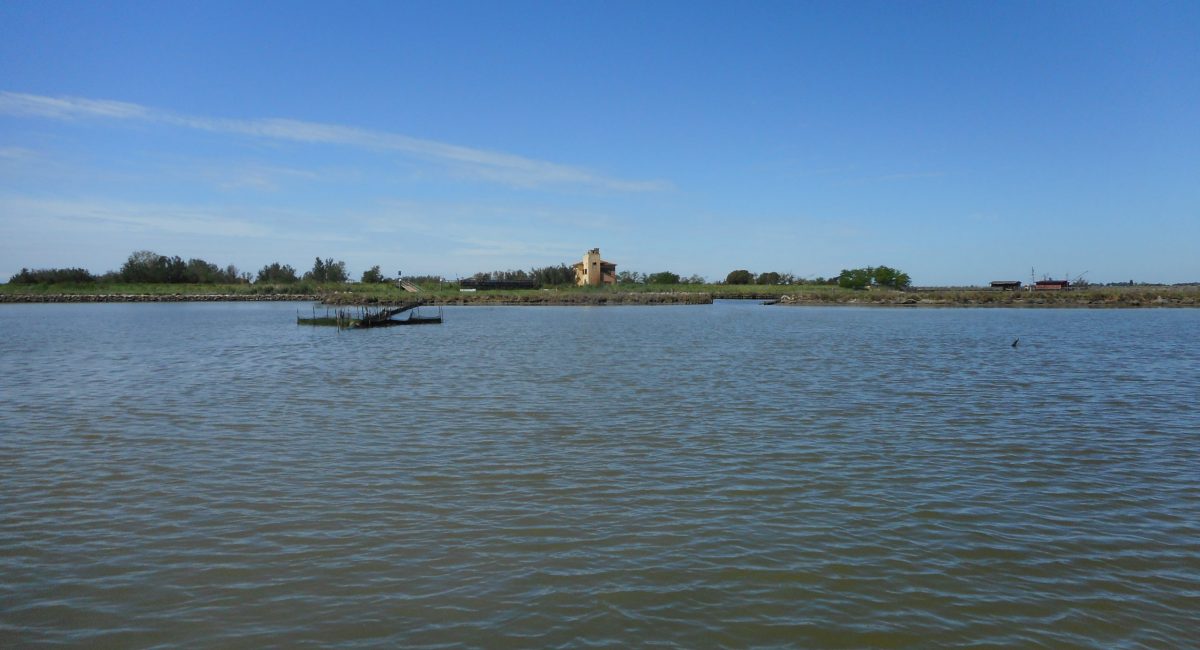Valli di Comacchio (IT4060002)
The Valli di Comacchio are the largest (over 100 km2) lagoon system in the Po River Delta (northern Adriatic Sea). The site is composed by a northern par which is reclaimed land, and by a lagoon system, the bigger lagoon portion, named “Grandi Valli” are completely surrounded by embankments, and are separated from the sea by the, 2.5 km wide Spina spit. On the opposite the smaller lagoons are directly connected to the sea. The “Grandi Valli” lagoon is connected with the Adriatic Sea by 2 marine channels, a third being almost permanently impounded. Freshwater inputs into the comes from the Reno River and a few drainage canals. Marine and freshwater inflows are regulated by sluice gates and dams. Water residence time has been estimated in 115 d. The lagoon have brackish waters, with salinity between 20 and 35 psu. The main basin, of about 10,000 hectares, has open waters in the central part and complex systems of bumps, salt marshes and emerging dunes in the perimeter areas. A long, well-established dune-like cordon, called Boscoforte, divides the biggest lagoon into two parts, Fossa di Porto to the west and Lido di Magnavacca to the east. Around the main basin there are some relics wetlands saved to the reclamation, such as Valle Zavelea, Ansa Fossa, Salina di Comacchio, Valle Capre, Valle Molino, Valle Spavola. A wide open brackish lagoon, called Valle Fattibello, finally connects the Valli di Comacchio with the town of Comacchio to the north. The river Reno and the drainage waters from reclamation are the main inflows of fresh water, while the salty waters come from the Adriatic Sea through three tributary channels. The open waters currently host rare populations of Ruppia cirrhosa, often in association with algae of the genera Chaetomorpha, Ulva, Cladophora, Ceramium, and pure populations of Lamprothamnium papulosum. The salt marshes and bumps, however, depending on the substratum and the duration of the outcrop from the waters, welcome different halophilous habitats: annual communities with Salicornia veneta, Salicornia patula, Suaeda maritima, Bassia hirsuta, Salsola soda, depending on the degree of humidity, soil characteristics, salinity and nutrients; perennial vegetation with Arthrocnemum fruticosum, Arthrocnemum perenne, Puccinellia palustris, Arthrocnemum glaucum, Halimione portulacoides, brackish meadows with Limonium serotinum, Juncus maritimus, Juncus acutus, Agropyron pungens, Aeluropus litoralis, Aster tripolium. Salicornia veneta, a species of priority interest, is present; Rare or endangered species such as Bassia hirsuta, Plantago cornuti, Limonium bellidifolium, Triglochin maritimum, Bassia hirsuta, Halocnemum strobilaceum are also reported.
Over the last 50 years the Valli di Comacchio have suffered anthropogenic impacts, from land reclamation (the Mezzano reclamation, executed in the 1960s, halved the surface of the lagoons), to the effects of contamination of the remaining basin. From the mid-1970s to 1990, the SIVALCO intensive aquaculture plant utilized the “Grandi Valli” as receiver and self-purification basin for waste waters from intensive aquaculture. Hyper-eutrophication of the lagoon resulted in the outbreak of a persistent bloom of picocyanobacteria. In the late 1980s, productive activities and fisheries collapsed, and the utilization of the Valli as a receiver for waste waters was finally interrupted in 1990, following SIVALCO bankruptcy. During the management of SIVALCO Spa all costs were financed by the EmiliaRomagna Region, however the management turned out to be bankrupt. During the management period of the Azienda Speciale Valli di Comacchio, personnel costs and interventions were always paid by the Emilia-Romagna Region, but structural interventions were reduced to a minimum. With the merging of the Azienda Speciale Valli di Comacchio into the Park, regional funding is only necessary to cover personnel costs and ordinary interventions. Meadows of the seagrass Ruppia cirrhosa characterized the bottom of the Valli in the early 1970s (Ferrari et al.,1972; Colombo et al., 1977). Actually in the Grandi Valli two broader water bodies are evident, with quite pronounced differences in most of the water properties: on the one hand Valle Fattibello, and the complex Valle Fossa di Porto-Valle Magnavacca on the other. Salinity, transparency and nutrient concentration differ greatly between the two water bodies. The reduced transparency in the complex Fossa di Porto-Magnavacca is due to a permanent bloom of the nitrophilic Nannochloropsis sp. (Andreoli et al.,1998). Valle Fattibello, which receives continental waters from the Navigabile channel and is directly connected to the sea through the Porto Canale, is characterized by higher water renewal, and better transparency (Mistri et al, 2000).

In the Natura 2000 site occur 17 Habitat, the habitat 1150* Coastal lagoon covers over 11558 ha. The site host 187 bird species of which 57 listed in Annex I of Bird Directive, and 9 species listed in Annex II of Habitat Directive, fishes, reptiles, mammals, amphibians and insects. The wide lagoon and the freshwater basins represent an elective environment for the stop, feeding and nesting of a very diversified aquatic avifauna comprising all the systematic groups.
The project will be implemented in the lagoon named “Valle Fattibello”, which is about 560 ha, it is one of the smaller lagoon but it is important since it is directly connected to the sea. A former project LIFE09 NAT/IT/000110 improved the conservation status of the habitat 1150*, it was implemented into the “Grandi Valli” and lead to a recolonization of aquatic angiosperms Ruppia cirrhosa in the southern portion of the larger lagoon. The project included the elaboration of the Management Plan of the site, which was approved into the year 2015, it foreseen action to foster the aquatic angiosperm recovery. Anyhow nowadays, the recolonization did not extend further, and did not spread out of the “Grandi Valli”, including in particular to the lagoon named “Valle Fattibello”. In fact, the current seagrass meadows are not enough widespread to trigger recolonization in other areas, last but not least the main lagoon of the site is not directly connected with sea, water inflows and outflows are regulated by sluice gates and dams.
